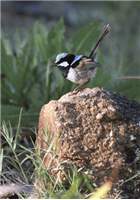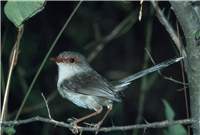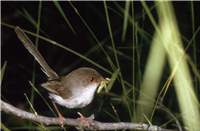Family
Maluridae
Genus
Malurus
Species
cyaneus
Threats/Control Methods - Regional
Prolonged droughts and bushfires threaten this small, vegetation dependant species in its native habitat.
Threats/Control Methods - Local
This small species lives close to the ground around suburban parks and gardens, leaving it vulnerable to Cats (Felis catus) attacks.
Local/Urban Actions
Planting thick, low-lying shrubs will encourage the tiny birds into suburban backyards. Cat predation on this and other small bird, mammal, reptile and frog species can be minimised by keeping cats indoors or by installing a specially designed outdoor cat park or enclosure.
Common Names
Superb Fairy-wren, Blue Wren, Jenny Wren
Distinguishing Features
Fairy-wrens are small birds, 13-14 cm in size, with raised tails. Adult male Superb Fairy-wrens have very bright rich blue and black breeding plumage above and on the throat. The belly is grey-white and the bill is black. Females and young birds are mostly brown with a dull red-orange area around the eye and a brown bill. Females have a pale greenish gloss on their otherwise brown tail. The legs are brown in both sexes.
Survey Techniques
Call and visual identification.
Species Call
A series of high pitched trills, which the male often extends into song.
Similar Species
There are many species of Fairy-wren in Australia. The males are fairly distinctive, however the females and the young from different species are similar looking. Both the Superb and White-winged Fairy-wrens (Malurus leucopterus) are similar in size, while the Variegated Fairy-wren (Malurus lamberti) is slightly larger in size and has a longer tail.
Distribution
Down the eastern states of Australia and across the SA and into TAS.
Country of Origin
Australia.
Conservation (Pet/Pest) Status - Regional
The superb Fairy-wren is the only Fairy-wren species in the ACT and is now the most common native woodland species in the region. Since 1981, bird numbers have increased three-fold, probably due to increased garden areas (COG).
Conservation (Pet/Pest) Status - National
Secure, not listed under the EPBC Act 1999.
LSCCES Population
The species is found very abundantly across the entire survey site, especially in well-vegetated areas.
Associated vegetation community
Thick shrubby areas and gardens with dense understorey vegetation.
Limiting Resources
Superb Fairy-wrens require good sheltered nesting sites of thick bushes. Large amount of ground cover and organic matter is also needed so they can forage for insects.
Breeding
The female builds a domed nest from grasses and fine twigs in concealed dense shrubs and bushes. Nest building takes place from August to November, with females laying 3-4 eggs. Dependant young can be found from September to late April, from either a first or second brood.
Behaviour
Superb Fairy-wrens live in family groups with a dominant male and female and other young males to help raise the young. The birds are quite sedentary and do not migrate, preferring to remain in a given territory.
Functional Group
Food Species
Superb Fairy-wrens feed on insects and other small arthropods and forage on the ground and in low-lying shrubs in small social groups.
Predators
Cats (Felis catus) and Pied Currawongs (Strepera graculina ) predate on Superb Fairy-wrens.
Interesting Fact
Male Superb Fairy-wrens have been labelled 'the most unfaithful birds in the world' as they will breed with many different females each season.
References - (reader suitability of references, P=Primary teachers, S=Secondary students, T=Tertiary students and researchers)
Books:Pizzey, G. 2000. The Graham Pizzey & Frank Knight Field Guide to the Birds of Australia. Angus & Robertson, Sydney. P, S, T
Taws, N. et al. 2001. Bringing Birds Back: A Glovebox Guide for Bird Identification and Habitat Restoration in ACT and SE NSW. Greening Australia ACT and SE NSW Inc. P, S, T
Veerman, P. 2003. Canberra Birds: A report on the first 21 years of the garden bird survey. Philip Veerman and Canberra Ornithologists Group. Canberra. S, T
Internet: Birds in Backyards. 2006. [online]. Available at:http://www.birdsinbackyards.net P, S, T
Canberra Ornithological Group (COG). 2004. Birds of Canberra Gardens. COG and the ACT Department of Urban Services. [online]. Available at:http://garden.canberrabirds.org.au/ P, S, T
ANU Reporter, Auturmn 2006. Trilly Love Songs. Could the pre-dawn song of the male superb fairy wren clinch the courtship deal? New research pointo to intriguiing possiblities for bird studies. http://info.anu.edu.au/mac/Newsletters_and_Journals/ANU_Reporter/097PP_2006/_02PP_Autumn/_wren.asp
Online Publications:Nix, H. and Cunningham, R. 2006. Birds of the Lower Sullivans Creek Catchment, Canberra ACT. Prepared for the Life in the Suburbs project using data from the Lower Sullivans Creek Catchment Ecological Survey (LSCCES). Australian National University. Canberra. [online]. Available at: http://www.lifeinthesuburbs.com.au/category.php?id=65 S, T



 Top
Top Top
Top